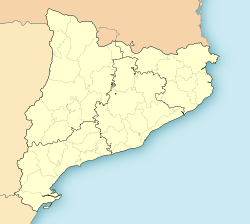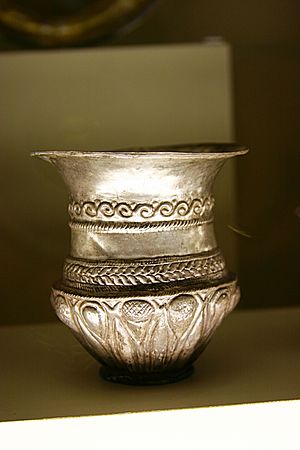Tivissa facts for kids
Quick facts for kids
Tivissa
|
||
|---|---|---|
|
Municipality
|
||

Tivissa from the air
|
||
|
||
| Country | ||
| Community | ||
| Province | Tarragona | |
| Comarca | Ribera d'Ebre | |
| Area | ||
| • Total | 209.4 km2 (80.8 sq mi) | |
| Elevation | 309 m (1,014 ft) | |
| Population
(2018)
|
||
| • Total | 1,639 | |
| • Density | 7.827/km2 (20.272/sq mi) | |
| Demonym(s) | Tivissà | |
Tivissa is a town located in the Ribera d'Ebre area of Catalonia, Spain. It sits below the La Llena massif. The municipality of Tivissa includes the main village, plus La Serra d'Almos (near the Montalt mountains), and the smaller villages of Darmós and Llaberia.
Contents
A Look Back in Time: Tivissa's History
Tivissa has a very long history, going back to ancient times.
Early Settlers and Cave Art
People lived in this area even before recorded history. We know this because cave paintings have been found in several spots close to the village. These paintings give us clues about how early humans lived.
Iberian Times: An Important Ancient Town
During the time of the Iberians, Tivissa was a very important community. The name "Tivissa" itself might even come from the Iberian language. You can still see the remains of an Iberian settlement at a place called Banyoles. It's about five kilometers from the modern village and looks over the Ebre river. These early settlements were important because they were on a trade route. This route went through the pass of Coll de Fatxes, connecting the coast of Tarragona to what is now Zaragoza.
Roman Influence and Medieval Walls
In the Roman period, special clay jars called amphorae were made in Tivissa. These jars traveled all the way to Rome! They were probably used to carry olive oil or wine. Later, in the Middle Ages, Tivissa had a castle. Around the year 1350, Tivissa became a town surrounded by protective walls. You can still see parts of these old walls today. Look for the gateways like Portal de l'Era, Portal d'Avall, and Portal de la Raval, as well as parts of the old castle.
What to See in Tivissa
Tivissa has some interesting places to visit, especially its main church.
The Unique Church of Tivissa
The main church in Tivissa looks like it was built in the 1800s, in a style called Renaissance. But when you go inside, it's actually in the older Gothic style!
The church was first built in the 1200s or 1300s on the site of an even older Romanesque building. More parts were added and changed between the 1500s and 1700s. The tall, eight-sided bell-tower was built in 1550.
In the 1800s, a local leader named Pere Rius wanted to build a bigger church. He got help from the town council and even from the president of the First Spanish Republic, Estanislau Figueres. Since there wasn't much space, they decided to build the new church around the old one. The plan was to tear down the old Gothic church after the new one was finished. However, when Pere Rius passed away in 1894, the building work stopped. The old Gothic church was never torn down, so it still stands inside the newer building today!
Castellet de Banyoles: Ancient Discoveries
One of the most important ancient Iberian settlements in Catalonia was found here in 1912. Even more exciting, a special collection of silver Iberian objects, known as the 'Treasure of Tivissa', was discovered in 1927. These objects were likely used for religious offerings.
The Iberian settlement covers a large area of 4.4 hectares (about 11 acres) on the left side of the River Ebre. It was built between the 6th and 4th centuries BC, or maybe even earlier. This location was perfect for controlling trade that traveled along the river into the country.
Ancient writers said that this area belonged to a tribe called the Ilercavones. When the Romans expanded their empire into this region, it likely led to the end of this settlement.
Tivissa's Economy: How People Make a Living
Today, Tivissa's economy mostly relies on farming. Even though some of the hilly land is difficult to farm, people still grow many crops.
Farming and Local Products
The main crops grown here are olives, grapes (used for making wine), and nuts like hazelnuts and almonds. Farmers also grow soft fruits such as peaches and cherries.
Growing Tourism
In recent years, more and more people have been visiting Tivissa. Tourism is becoming an important part of the local economy, bringing new opportunities to the area.
Weather Watchers
Near the small village of Llaberia, the Spanish National Institute of Meteorology has set up a weather radar. This helps them track weather patterns and forecast the weather.
See also
 In Spanish: Tivisa para niños
In Spanish: Tivisa para niños




